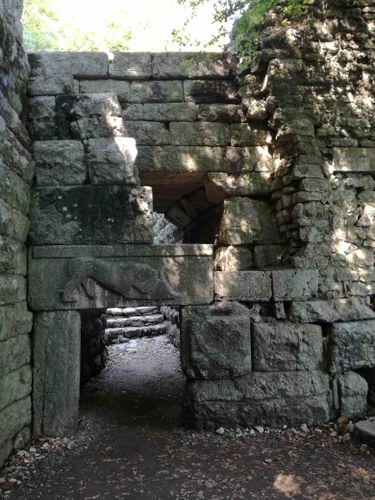Lion Gate

It was discovered by Ugolini between 1928 and 1935. It was one of the access to the acropolis from the northern bay during Classical and Hellenistic Age. It takes its name from the lintel depicting a lion devouring a bull, considered to be Archaic or of Archaic inspiration. The gate we see today is the result of a Medieval times reconstruction, when the original gateway was reduced by positioning a monolith on the south side and a second block of great dimension used as lintel, thus creating a partial overlap between two wall lines and the subsequent passage. Above the architrave there is another row of blocks that fill the space left by the original entrance. It is clear that the architrave with the lion is a later addition because the south wall of the entrance has been reduced to accomodate it.
The opening is not wide, and the main beams are held up by large shelves. The roof of the gateway is built using profiled consoles protruding from the side walls and supporting stones partly carried by the flanking walls. Above the ceiling there is a row of profiled stones which supported a second ceiling. Hammond believed that the narrowed entrance forming the second phase of the gate was created after the double ceiling had been exposed, which means that the new façade was designed to conceal the gap between the two ceilings with a new false architrave (the one with the lion). This gate was not used for the passage of vehicles, so reducing the entrance was not a problem.
Both Ugolini and Zheku date the reconstruction of the gate to Late Antiquity, around the 6th century AD, while Karaiskaj believed that it took place during the 1st century AD, under the reign of Augustus. He also stated that it was built after the Lake Gate, both for its position in front of the passage and for the different style of construction.
Bibliography on the subject
- Ceka N, "La fortification antique de Butrint et le territoire des Prasaibes" in Monumentet, vol. 12, 1976, pp. 27-48
-
Hammond N. G. L, Epirus. The geography, the ancient remains, the history and the topography of Epirus and adjacent areas, Oxford, Clarendon Press, 1967, pp. 104-105
- Karaiskaj G., Crowson A. (edt), The fortifications of Butrint, English edition of Butrinti dhe fortifikimet e tij (Tirana 1986), London-Tirana, Butrint Foundation, 2009, pp. 38-42
- Martin S., "The topography of Butrint" in Hodges, Bowden and Lako, Byzantine Butrint: excavations and surveys 1994-99, Oxford, 2004, pp. 76-103
- Zheku K., "La restauration de la Porte du Lion a Butrint" in Monumentet, vol. 1, 1971, pp. 79-86
- Ugolini L. M., Butrinto. Il mito di Enea. Gli scavi, Istituto grafico tiberino, 1937, pp. 119-121
- Ugolini L. M., L‘acropoli di Butrinto, Roma, 1942, pp. 56-65